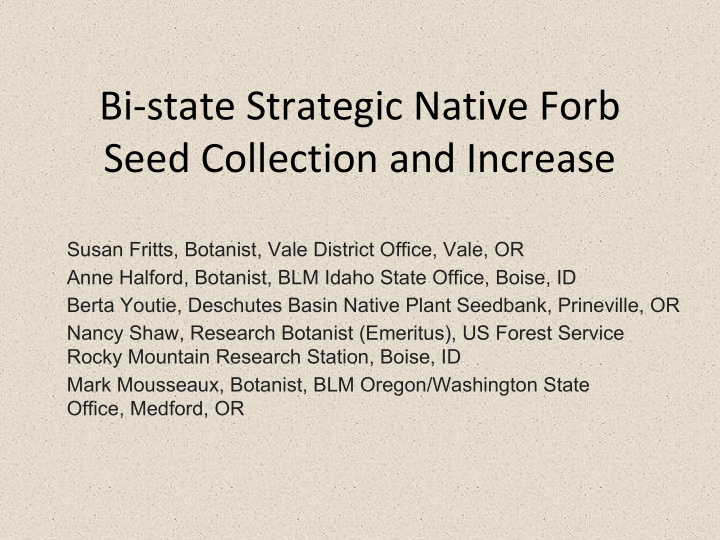



Bi-state Strategic Native Forb Seed Collection and Increase Susan Fritts, Botanist, Vale District Office, Vale, OR Anne Halford, Botanist, BLM Idaho State Office, Boise, ID Berta Youtie, Deschutes Basin Native Plant Seedbank, Prineville, OR Nancy Shaw, Research Botanist (Emeritus), US Forest Service Rocky Mountain Research Station, Boise, ID Mark Mousseaux, Botanist, BLM Oregon/Washington State Office, Medford, OR
Why Forb Increase Now? • Secretarial Order 3336 – Expand efforts to utilize native seed, where appropriate, to accelerate efforts to improve and restore post-fire rangeland health • Greater Sage-Grouse Approved Resource Management Plan Amendments for Ten Western States – Re-establish sagebrush, native grass, and forb cover in areas where they have been reduced below desired levels or lost – Increase plant diversity and sagebrush cover in crested wheatgrass seedlings – Use native plant materials for restoration and rehabilitation based on availability, adaptive capacity, and probability for successful establishment – Use provisional and established seed zones identified by the Great Basin Native Plant Project to determine appropriate seed sources
Why Forb Increase Now? • National Seed Strategy for Rehabilitation and Restoration – Identify seed needs and ensure reliable availability of genetically appropriate material by improving agency and partner capacity to plan for seed needs by seed zone – Assess and implement alternative seed production methods for “workhorse” grass, forb, and shrub species to augment wildland seed collection
Goal Have genetically appropriate forb seed available for restoration of Greater Sage-grouse habitat.
Large Scale Seed Increase Benefits • Economy of scale • Increase supply to decrease price
How did we choose where to focus our efforts? • Provisional seed zone –Bower et. al., 2010
Sage Grouse Priority Conservation Areas 15-20 degree F/6-12
Target Seed Collection Areas
Species Selection • Sage-grouse Preferred Forb List • Species that are not currently in production • Species found throughout our focal area • Ease of growing in agricultural setting for seed increase i.e. genera that have been grown before as opposed to genera that have never been grown in production • Benefit pollinators
Priority Collection List 2016
Collection Goal • PLS/ sq foot is based on what could be found in literature and professional knowledge • Important to round up targets
How to Get the Seed Collected • Contracts • Seeds of Success program/Summer Interns • Excess seed from previous seed collection
Logistics • Make sure collections receive a unique collection number • Use the Seeds of Success form to document the collection site • Proper storage before cleaning • Long term storage to maintain viability
Results from 2016 Collections
What could go wrong?!? • Species not located throughout the range or only in limited habitats such as upper elevations, use PNW Consortium of Herbaria database • Low abundance of plants or seed available for collection • Low PLS from collected seed • Potential ploidy issues with Crepis accuminata
Priority Collection List for 2017 • Chaenactis douglasii • Lomatium triternatum • Machaeranthera canescens • Nothocalais troximoides
Next Steps • Continue seed collection with our revised list • Write contract for commercial seed increase • Start seed increase with wildland seed via contracts
Timeline Year 1 • Identify focus area and target species • Hire collectors or write contract • Collect seed Year 2 • Continue collections • Write contract for seed increase • Start growing seed
Timeline Year 3 • Continue seed growing • Possible seed harvest Year 4 • Seed harvest • Possibly start using seed for restoration
Huge thank you to: Anne Halford – Idaho BLM Nancy Shaw and the Great Basin Native Plant Project Mark Mousseaux – Oregon BLM Berta Youti - Deschutes Basin Native Plant Seedbank Caryn Burri, Grace Haskins, and Kristin Williams – Oregon BLM Peggy Olwell – Washington Office BLM For more information on: Seeds of Success https://www.blm.gov/programs/natural-resources/native-plant-comm unities Great Basin Native Plant Project http://www.greatbasinnpp.org/
Questions?
The preceding presentation was delivered at the 2017 National Native Seed Conference Washington, D.C. February 13-16, 2017 This and additional presentations available at http://nativeseed.info
Recommend
More recommend